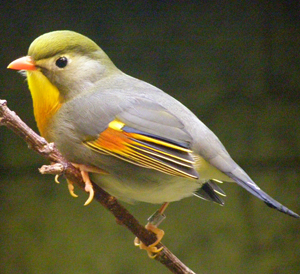Hunan Province

Birding Hunan
This south-central China province is located in the middle reaches of the Yangtze River and its topography is dominated by low mountains and hills. The fertility of the land and its well developed water system formed by Xiangjiang River, Zijiang River, Yuan River and Lishui River, has led to Hunan becoming known as the ‘Land of Rice and Fish’ (the Chinese expression equivalent to the English ‘Land of Milk and Honey’). The capital of the province is Changsha, which has a 2000 year history.The province has the second largest freshwater lake in China, Dongting Lake. Its subtropical evergreen broad-leaved forest consists of 248 plant families, with over 5000 species including precious plants such as the silver fir, metasequoia, waterpine, ginkgo and dove trees. These are ideal habitat for water birds and forest birds. Up to now, records in Hunan comprise 71 bird families, represented by 448 species (c.34% of the national total). Among them are 64 nationally protected species. In 2007, Red-billed Leiothrix Leiothrix lutea was chosen as the ‘state bird’ of Hunan Province. Hunan has a subtropical humid ‘monsoon’ climate with features of both continental and marine climates.
-
Dongting Lake Wetlands
InformationSatellite ViewDongting Lake is the third largest lake in China made up of East, South and West Dongting Lake, Dongting Lake Wetlands Reserve was established in 1982 and upgraded to national level reserve in 1994. It was accepted in the list of Ramsar sites in 2002. According to the survey of 2007, 297 species of birds were recorded in East Dongting Lake, 164 species of birds were recorded in South Dongting Lake and 217 species of birds were recorded in West Dongting Lake. A Bird-watching Festival is held at Dongting Lake each year. -
Huping Shan Reserve
InformationSatellite ViewHupingshan Reserve was granted National Reserve status in 1994. In 1996 the reserve recorded 143 bird species. Among them there are 49 species of summer breeders, 14 species of over-wintering birds and 80 residents. Endangered bird species here include Reeve’s Pheasant Syrmaticus reevesii, Brown-chested Jungle Flycatcher Rhinomyias brunneata and Silver Oriole Oriolus mellianus. -
Jiangkou Niaozhou Nature Reserve
InformationSatellite ViewJiangkou Niaozhou Nature Reserve, which is 41 kilometers from Hengyang City, is the smallest protected area in the province but has the richest bird fauna. There are 181 regularly recorded bird species here, including the internationally endangered Siberian Crane Grus leucogeranus. Endangered bird species include Oriental Stork Cicnia boyciana, Swan Goose Anser cygnoides and Baikal Teal Anas formosa. -
Wulingyuan
InformationSatellite ViewWulingyuan, which UNESCO listed as world heritage site in 1992, lies in the Zhangjiajie region of Hunan Province. It consists of 5 nature reserves: Zhangjiajie National Forest Park, Zhangjiajie Nature Reserve, Zhangjiajie Giant Salamander Reserve, Tianzishan Nature Reserve and Suoxiyu Nature Reserve. In 1999 this region recorded 31 species of summer breeders and 58 resident birds. Endangered bird species in this region are Elliot’s Pheasant Syrmaticus ellioti and Brown-chested Jungle Flycatcher Rhinomyias brunneata.
-
Philip He
Sichuan Province
http://www.alpinebirding.com
-
Number of bird species: 448
(As at August 2018)
-
NFP Zhangjiajie
InformationSatellite View…there are 27 species of beasts, 41 species of birds. Musk deer, civet, blue sheep, giant salamander and other animals are listed under the state protection… -
NNR Dupangling
InformationSatellite ViewThe protected area mainly protects the most typical and representative vegetation and forest ecosystems in the subtropical transitional zone, it is a forest ecosystem. -
NNR Huping Shan
InformationSatellite ViewHupingshan Reserve was granted National Reserve status in 1994. In 1996 the reserve recorded 143 bird species. Among them there are 49 species of summer breeders, 14 species of over-wintering birds and 80 residents. Endangered bird species here include Reeve’s Pheasant Syrmaticus reevesii, Brown-chested Jungle Flycatcher Rhinomyias brunneata and Silver Oriole Oriolus mellianus. -
NNR Nanyue Hengshan
Observatory WebsiteSatellite View -
NR Dongdong Tinghu
InformationSatellite ViewThe Reserve has been listed as a Wetland of International Importance. Its main protection targets are wetland and rare bird species. A freshwater lake with numerous smaller lakes and ponds, marsh, swamp and wet grassland fed by flooding from the Yangtze and four other rivers… -
NR Jiangkou Niaozhou
InformationSatellite ViewThe nature reserve is 35 km from Hengyang City, on the lower Lai He River, and is formed by the islands of Chenzhou, Zhangzhou and Longzhou. -
NR Suoxi Valley
InformationSatellite ViewThe Suoxi Valley Nature Reserve is situated in the northeast section of the Wulingyuan Scenic and Historic Interest Area of Zhangjiajie in Hunan Province. China’s largest karst cave is located here as well as a lake among the narrow gorges, and the rolling mountains of different shapes... -
NR Tianzishan
WebpageSatellite ViewThe Tianzi Mountian is located in between Sangzhi County, Suoxi Valley and Zhangjiajie and is one of the four scenic zones in Wulingyuan. -
WWT Nan Dongting
InformationSatellite ViewLocated in the southern part of Dongting Lake, the largest lake on the plains of the middle reaches of the Yangtze River, the site supports important numbers of endangered Oriental Stork Ciconia boyciana and Siberian Crane Grus leucogeranus…
-
Alpine Birding
Tour OperatorBirding trips here are made for avid birders including yearly-run trips and new China birding trips developed by AlpineBirding team and guided by our bird experts in the best.

